[English] 日本語
 Yorodumi
Yorodumi- PDB-2pqi: Crystal structure of active ribosome inactivating protein from ma... -
+ Open data
Open data
- Basic information
Basic information
| Entry | Database: PDB / ID: 2pqi | ||||||
|---|---|---|---|---|---|---|---|
| Title | Crystal structure of active ribosome inactivating protein from maize (b-32) | ||||||
 Components Components | Ribosome-inactivating protein 3 | ||||||
 Keywords Keywords | HYDROLASE / MOD / ribosome inactivating protein / maize / Plant defense / Protein synthesis inhibitor / Toxin | ||||||
| Function / homology |  Function and homology information Function and homology informationrRNA N-glycosylase / rRNA N-glycosylase activity / defense response / toxin activity / negative regulation of translation / cytoplasm Similarity search - Function | ||||||
| Biological species |  | ||||||
| Method |  X-RAY DIFFRACTION / X-RAY DIFFRACTION /  MOLECULAR REPLACEMENT / Resolution: 2.5 Å MOLECULAR REPLACEMENT / Resolution: 2.5 Å | ||||||
 Authors Authors | Mak, A.N.S. / Wong, Y.T. / Young, J.A. / Cha, S.S. / Sze, K.H. / Au, S.W.N. / Wong, K.B. / Shaw, P.C. | ||||||
 Citation Citation |  Journal: Nucleic Acids Res. / Year: 2007 Journal: Nucleic Acids Res. / Year: 2007Title: Structure-function study of maize ribosome-inactivating protein: implications for the internal inactivation region and the sole glutamate in the active site. Authors: Mak, A.N. / Wong, Y.T. / An, Y.J. / Cha, S.S. / Sze, K.H. / Au, S.W. / Wong, K.B. / Shaw, P.C. #1: Journal: J.Biol.Chem. / Year: 1991 Title: Characterization and molecular cloning of a proenzyme form of a ribosome-inactivating protein from maize. Novel mechanism of proenzyme activation by proteolytic removal of a 2.8-kilodalton ...Title: Characterization and molecular cloning of a proenzyme form of a ribosome-inactivating protein from maize. Novel mechanism of proenzyme activation by proteolytic removal of a 2.8-kilodalton internal peptide segment. Authors: Walsh, T.A. / Morgan, A.E. / Hey, T.D. | ||||||
| History |
|
- Structure visualization
Structure visualization
| Structure viewer | Molecule:  Molmil Molmil Jmol/JSmol Jmol/JSmol |
|---|
- Downloads & links
Downloads & links
- Download
Download
| PDBx/mmCIF format |  2pqi.cif.gz 2pqi.cif.gz | 146.1 KB | Display |  PDBx/mmCIF format PDBx/mmCIF format |
|---|---|---|---|---|
| PDB format |  pdb2pqi.ent.gz pdb2pqi.ent.gz | 114.8 KB | Display |  PDB format PDB format |
| PDBx/mmJSON format |  2pqi.json.gz 2pqi.json.gz | Tree view |  PDBx/mmJSON format PDBx/mmJSON format | |
| Others |  Other downloads Other downloads |
-Validation report
| Summary document |  2pqi_validation.pdf.gz 2pqi_validation.pdf.gz | 449.8 KB | Display |  wwPDB validaton report wwPDB validaton report |
|---|---|---|---|---|
| Full document |  2pqi_full_validation.pdf.gz 2pqi_full_validation.pdf.gz | 484.1 KB | Display | |
| Data in XML |  2pqi_validation.xml.gz 2pqi_validation.xml.gz | 30.5 KB | Display | |
| Data in CIF |  2pqi_validation.cif.gz 2pqi_validation.cif.gz | 40.9 KB | Display | |
| Arichive directory |  https://data.pdbj.org/pub/pdb/validation_reports/pq/2pqi https://data.pdbj.org/pub/pdb/validation_reports/pq/2pqi ftp://data.pdbj.org/pub/pdb/validation_reports/pq/2pqi ftp://data.pdbj.org/pub/pdb/validation_reports/pq/2pqi | HTTPS FTP |
-Related structure data
| Related structure data |  2pqgSC  2pqjC S: Starting model for refinement C: citing same article ( |
|---|---|
| Similar structure data |
- Links
Links
- Assembly
Assembly
| Deposited unit | 
| ||||||||
|---|---|---|---|---|---|---|---|---|---|
| 1 | 
| ||||||||
| 2 | 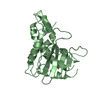
| ||||||||
| 3 | 
| ||||||||
| Unit cell |
|
- Components
Components
| #1: Protein | Mass: 27305.551 Da / Num. of mol.: 3 Source method: isolated from a genetically manipulated source Source: (gene. exp.)   References: UniProt: P25891, UniProt: P28522*PLUS, rRNA N-glycosylase #2: Water | ChemComp-HOH / | |
|---|
-Experimental details
-Experiment
| Experiment | Method:  X-RAY DIFFRACTION / Number of used crystals: 1 X-RAY DIFFRACTION / Number of used crystals: 1 |
|---|
- Sample preparation
Sample preparation
| Crystal | Density Matthews: 2.1 Å3/Da / Density % sol: 41.52 % |
|---|---|
| Crystal grow | Temperature: 299 K / Method: vapor diffusion, sitting drop / pH: 8.5 Details: 0.2 M Sodium acetate tri-hydrate, 0.1 M Tris-HCl pH 8.5, 30% PEG 4000, VAPOR DIFFUSION, SITTING DROP, temperature 299K |
-Data collection
| Diffraction | Mean temperature: 100 K |
|---|---|
| Diffraction source | Source:  ROTATING ANODE / Type: RIGAKU MICROMAX-007 / Wavelength: 1.54178 Å ROTATING ANODE / Type: RIGAKU MICROMAX-007 / Wavelength: 1.54178 Å |
| Detector | Type: RIGAKU RAXIS IV / Detector: IMAGE PLATE / Date: Nov 1, 2006 |
| Radiation | Protocol: SINGLE WAVELENGTH / Monochromatic (M) / Laue (L): M / Scattering type: x-ray |
| Radiation wavelength | Wavelength: 1.54178 Å / Relative weight: 1 |
| Reflection | Resolution: 2.5→20 Å / Num. all: 21654 / Num. obs: 21654 / % possible obs: 93.9 % / Observed criterion σ(F): 0 / Observed criterion σ(I): 0 / Redundancy: 2.4 % / Rmerge(I) obs: 0.031 / Net I/σ(I): 22.2 |
| Reflection shell | Resolution: 2.5→2.59 Å / Redundancy: 2 % / Rmerge(I) obs: 0.153 / Mean I/σ(I) obs: 4.1 / % possible all: 90.1 |
- Processing
Processing
| Software |
| |||||||||||||||||||||||||
|---|---|---|---|---|---|---|---|---|---|---|---|---|---|---|---|---|---|---|---|---|---|---|---|---|---|---|
| Refinement | Method to determine structure:  MOLECULAR REPLACEMENT MOLECULAR REPLACEMENTStarting model: PDB entry 2PQG Resolution: 2.5→20 Å / Cross valid method: THROUGHOUT / σ(F): 0 / σ(I): 0 / Stereochemistry target values: Engh & Huber
| |||||||||||||||||||||||||
| Refinement step | Cycle: LAST / Resolution: 2.5→20 Å
| |||||||||||||||||||||||||
| Refine LS restraints |
|
 Movie
Movie Controller
Controller


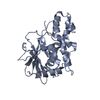
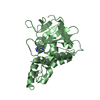
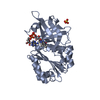
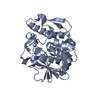
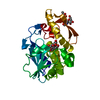
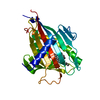
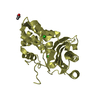


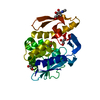
 PDBj
PDBj


